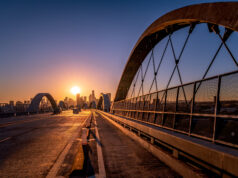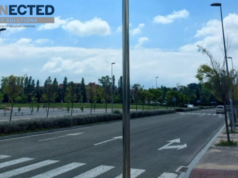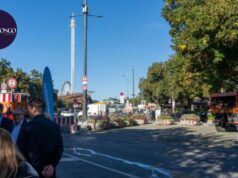A lighting pole is no longer just a lighting pole, but a platform for a range of sensors which can deliver and respond to data spanning climate, road and foot traffic and security. This was one of the key takeaways from IPWEA member Graham Mawer’s visit to the Smart City Expo World Congress (SCEWC) in Barcelona in November.
Mawer, who consults to IPWEA on new technology while operating lighting consultancy company, Next Energy Lighting, was one of the leaders of the IPWEA delegation to SCEWC, which attracts over 25,000 delegates from around the world along with 1100 exhibitors and over 600 speakers.
In its size, technology and breadth of topics, SCEWC was – in the words of one delegate member, “like travelling the world in one expo.”
IPWEA is an official event partner for SCEWC, and the Australian delegation also included the Internet of Things Alliance Australia (IoTAA), the Australian Smart Communities Association and the Digital Twin Partnership.
Delegation member Michelle Marijnen, a chartered civil engineer from the Light Regional Council in South Australia, described SCEWC as a “profoundly enriching experience.”
“I acquired significant knowledge from the panel discussions focused on sustainability and resilient infrastructure in a dynamic context,” she said.
“The side events facilitated the establishment of invaluable global connections among governments, academia, and the private sector, which I continue to nurture.
“A particularly memorable aspect was the opportunity to engage with prominent leaders in the smart city sector, allowing me to pose critical questions regarding creating cities that will serve future generations sustainably and effectively.”
Graham Mawer concedes that he has a particular interest in lighting, but says the trends at SCEWC are much more wide ranging.
He cites sustainability, standardisation and interoperability, AI and data analytics, smart mobility and infrastructure among some of the leading trends at this year’s event.
Lighting, however, is significant as this is where many smart city technologies are converging – with poles increasingly the home of smart lighting, CCTV, public WiFi, 4G/5G small cells and a growing array of sensors.
One notable transformation underway, particularly in Europe, is the impact on the lighting sector and other industries of Extended Producer Responsibility regulations.
These European regulations require producers to fund the recycling or recovery of their products at the end of their life cycles, providing a major driver for sustainability.
“This has changed the whole thinking about what a product is and what its life cycle looks like,” said Mawer.
“If you have to be responsible for it on the back end, you don’t want to design it badly on the front end.”
In Europe, producers are building light poles in wood, and there are multiple experiments with colour temperature with a view to making lighting less harmful to insects and birds.
“There is one luminaire we saw that can produce 250 million colours that are infinitely controllable,” said Mawer.
“There was also a lot of emphasis on light pollution at SCEWC. Where I live in Sydney there are old spherical luminaires on the beach front and 70% of that goes straight into the night sky. It’s not doing anything for humans and it’s only causing environmental harm and sky glow.”
While Australia does not have the producer responsibility regulations of Europe, many of the European producers are selling their products in Australia and some Australian projects are world leading.
“In Sydney we have one of the largest deployments in the world of lights on main roads which are smart controlled and able to take sensors,” said Mawer.
“We are probably sitting on around 75% LED’s nationally on the street lighting network. That is ahead of where the US, Canada and much of Europe have got to with LEDs. We are now starting to see major smart controls projects emerging like the one in Sydney with Ausgrid and 33 of the NSW councils.”
“Smart controls can talk back to the operator and tell them what light they are connected to, where it is, how much energy has been used, if there is something wrong or if they are malfunctioning,” said Mawer.
“They can also dim in the off peak to save more energy. For example, at 11 o’clock they can take the lighting down a level and then back up again at 5 am, so there’s a lot of benefits to these systems.”
Sensors fitted to lighting can also monitor traffic, not only counting traffic but disaggregating between cars, trucks, bicycles and pedestrians.
“As we saw at SCECW, all this is being driven by interoperability and compatibility across suppliers. You can increasing take any sensor for a range of applications and plug it into any fitting on a light,” said Mawer.
“Street lights look increasingly like a natural home for sensors. Name any other piece of powered infrastructure that is placed at every 30 or 80 metres on every urbanised street in the world.
“Using light poles for sensing task is just a really clever asset recycling play. It lets us use an asset which we have already installed and paid for.”














